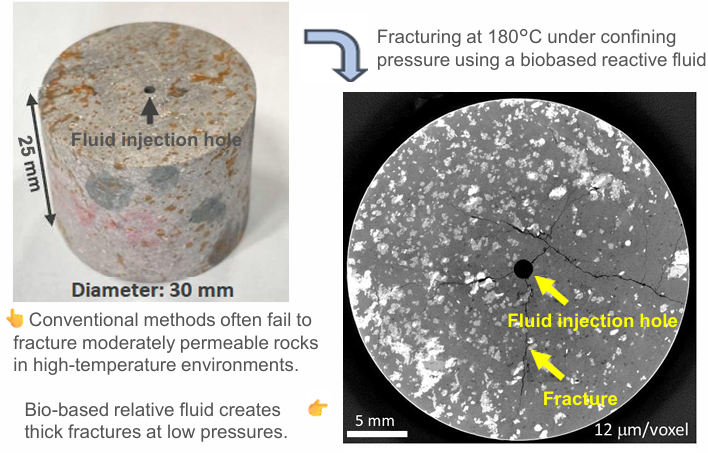Safe, Efficient, and Eco-Friendly Subsurface Rock Fracturing
Fracturing with biobased reactive fluid
Overview
In the development of subsurface energy infrastructures—such as geothermal power generation, geological storages of carbon dioxide (CCS) and renewable- energy-based hydrogen—it is essential to artificially create highly permeable fractures in rocks at depths of 1,000 to 5,000 meters and temperatures ranging from approximately 30°C to 300°C, in order to secure fluid pathways. In recent years, there has been a growing demand for the development of safer, more efficient, and environmentally friendlier technologies.
Conventional hydraulic fracturing is a purely mechanical technique that fractures rock by injecting high-pressure fluid through a wellbore. However, this method faces several technical and environmental limitations, including concerns over induced seismicity from high-pressure injections, and difficulty in maintaining fracture openings and fluid loss especially in moderately permeable rocks. These challenges have highlighted the need for innovative chemical-based approaches—particularly those grounded in green chemistry principles.
This invention introduces an innovative fracturing technique that utilizes biobased reactive fluid having high viscosity. This method chemically weakens the rock while forming and propagating fractures at relatively low pressures. Furthermore, by dissolving and roughened the fracture surfaces, the method helps maintain fracture openings and improves permeability over time.

Fracturing is possible at challenging conditions!

Product Application
・Development of subsurface energy resources
・Geological storage of CO2 and hydrogen
Related Works
[1] Obata et al., "Characteristics and optimization of hydraulic fracturing in volcanic natural gas reservoirs" (Abstracts of the 2025 Spring Meeting of The Japanese Association for Petroleum Technology)
IP Data
IP No. : JP2025-77753
Inventor : WATANABE Noriaki, WATANABE Yuto, OBATA Nagi
keyword : CO2 storage, CCS, geological storage of hydrogen, Development of natural hydrogen resources, fracturing
